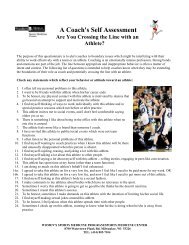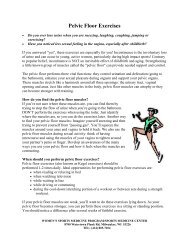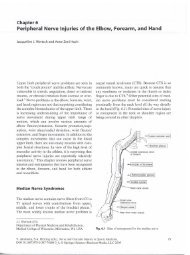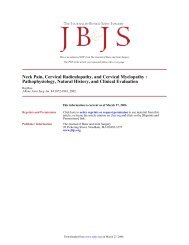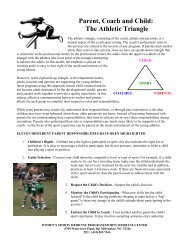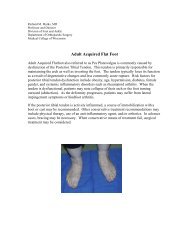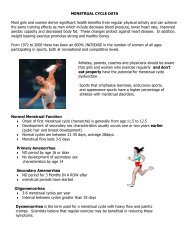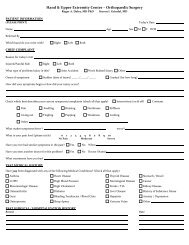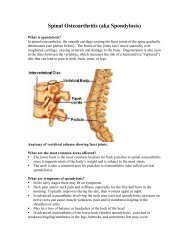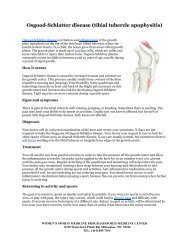Prevalence of Female Athlete Triad Characteristics in a Club ...
Prevalence of Female Athlete Triad Characteristics in a Club ...
Prevalence of Female Athlete Triad Characteristics in a Club ...
Create successful ePaper yourself
Turn your PDF publications into a flip-book with our unique Google optimized e-Paper software.
BRIEF REPORT<br />
<strong>Prevalence</strong> <strong>of</strong> <strong>Female</strong> <strong>Athlete</strong> <strong>Triad</strong> <strong>Characteristics</strong> <strong>in</strong> a <strong>Club</strong><br />
Triathlon Team<br />
Anne Z. Hoch, DO, John E. Stavrakos, MD, Jane E. Schimke, AAS<br />
681<br />
ABSTRACT. Hoch AZ, Stavrakos JE, Schimke JE. <strong>Prevalence</strong><br />
<strong>of</strong> female athlete triad characteristics <strong>in</strong> a club triathlon<br />
team. Arch Phys Med Rehabil 2007;88:681-2.<br />
Objective: To determ<strong>in</strong>e the prevalence <strong>of</strong> the female athlete<br />
triad <strong>in</strong> club triathletes.<br />
Design: Cross-sectional.<br />
Sett<strong>in</strong>g: Academic medical center <strong>in</strong> the midwestern United<br />
States.<br />
Participants: Fifteen women (mean age, 356y).<br />
Interventions: Not applicable.<br />
Ma<strong>in</strong> Outcome Measures: Disordered eat<strong>in</strong>g and menstrual<br />
status were determ<strong>in</strong>ed by questionnaires. Energy status was determ<strong>in</strong>ed<br />
by a 3-day food record, rest<strong>in</strong>g energy expenditure, and exercise<br />
energy output. Bone m<strong>in</strong>eral density (BMD) was measured <strong>in</strong> the<br />
total left hip and lumbar sp<strong>in</strong>e (L2-4) by dual-energy x-ray<br />
absorptiometry.<br />
Results: Sixty percent <strong>of</strong> the triathletes were found to be <strong>in</strong><br />
calorie deficit, 53% had a carbohydrate deficit, 47% had a fat<br />
deficit, 40% had a prote<strong>in</strong> deficit, and 33% had a calcium deficit.<br />
Forty percent <strong>of</strong> triathletes reported a history <strong>of</strong> amenorrhea.<br />
BMD was normal <strong>in</strong> the lumbar sp<strong>in</strong>e (L2-4) (1.30.1g/cm 2 ) and<br />
total left hip (1.10.1g/cm 2 ).<br />
Conclusions: Triathletes are at risk for components <strong>of</strong> the<br />
female athlete triad. Cont<strong>in</strong>ued efforts need to be directed at<br />
prevention through education <strong>of</strong> athletes, coaches, parents, and<br />
health care pr<strong>of</strong>essionals.<br />
Key Words: Amenorrhea; Athletics; Eat<strong>in</strong>g disorders; <strong>Female</strong>;<br />
Rehabilitation.<br />
© 2007 by the American Congress <strong>of</strong> Rehabilitation Medic<strong>in</strong>e<br />
and the American Academy <strong>of</strong> Physical Medic<strong>in</strong>e and<br />
Rehabilitation<br />
IN A WORLD INCREASINGLY devoted to participation <strong>in</strong><br />
pr<strong>of</strong>essional and recreational athletic events, the triathlon has<br />
ga<strong>in</strong>ed significant attention with<strong>in</strong> the past 2 decades. A triathlon<br />
is def<strong>in</strong>ed as consecutive swimm<strong>in</strong>g, bik<strong>in</strong>g, and runn<strong>in</strong>g events <strong>of</strong><br />
vary<strong>in</strong>g distances. The diversity <strong>of</strong> tra<strong>in</strong><strong>in</strong>g and the development<br />
<strong>of</strong> a balanced degree <strong>of</strong> fitness have contributed to the success <strong>of</strong><br />
this athletic endeavor.<br />
The female athlete triad (triad) is an <strong>in</strong>terrelated condition <strong>of</strong><br />
disordered eat<strong>in</strong>g, amenorrhea, and osteoporosis. It appears to be<br />
more common <strong>in</strong> endurance and aesthetic sports.<br />
The purpose <strong>of</strong> this study was to determ<strong>in</strong>e the prevalence <strong>of</strong><br />
triad characteristics <strong>in</strong> a recreational women’s triathlon team.<br />
From the Women’s Sports Medic<strong>in</strong>e Program/Sports Medic<strong>in</strong>e Center, Departments<br />
<strong>of</strong> Orthopaedic Surgery (Hoch, Stavrakos, Schimke) and Physical Medic<strong>in</strong>e<br />
and Rehabilitation (Hoch, Stavrakos), Medical College <strong>of</strong> Wiscons<strong>in</strong>, Milwaukee, WI.<br />
No commercial party hav<strong>in</strong>g a direct f<strong>in</strong>ancial <strong>in</strong>terest <strong>in</strong> the results <strong>of</strong> the research<br />
support<strong>in</strong>g this article has or will confer a benefit upon the authors or upon any<br />
organization with which the authors are associated.<br />
Repr<strong>in</strong>t requests to Anne Z. Hoch, DO, Women’s Sports Medic<strong>in</strong>e Program/Sports<br />
Medic<strong>in</strong>e Center, Depts <strong>of</strong> Orthopaedic Surgery/Physical Medic<strong>in</strong>e and Rehabilitation,<br />
9200 W Wiscons<strong>in</strong> Ave, Medical College <strong>of</strong> Wiscons<strong>in</strong>, Milwaukee, WI 53226,<br />
e-mail: azeni@mcw.edu.<br />
0003-9993/07/8805-11346$32.00/0<br />
doi:10.1016/j.apmr.2007.02.035<br />
METHODS<br />
Fifteen women from the same triathlon team volunteered to<br />
participate <strong>in</strong> this study and signed an <strong>in</strong>formed consent <strong>in</strong><br />
accordance with our <strong>in</strong>stitutional review board. All <strong>of</strong> the<br />
triathletes competed at a recreational level except for 2 who<br />
were pr<strong>of</strong>essionals. Subjects tra<strong>in</strong>ed on an average <strong>of</strong> 5 days<br />
per week for at least 90 m<strong>in</strong>utes. Subjects reported start<strong>in</strong>g<br />
athletics at a mean age <strong>of</strong> 12.6 years. None had a history <strong>of</strong><br />
anorexia or bulimia. Subjects completed menstrual and health<br />
questionnaires, which were reviewed by the primary <strong>in</strong>vestigator<br />
(AZH). Eat<strong>in</strong>g habits and attitudes were assessed by the<br />
Eat<strong>in</strong>g Attitude Test (EAT-26), which has been validated for<br />
anorexia. 1 Each subject completed a body image questionnaire.<br />
We calculated energy status on each subject from a prospective<br />
3-day food diary 2 us<strong>in</strong>g a Nutrient Analysis program. a<br />
Rest<strong>in</strong>g energy expenditure (REE) was calculated by the Harris-<br />
Benedict equation and multiplied by an activity factor <strong>of</strong> 1.1,<br />
which was used to estimate energy expended from daily activities<br />
<strong>of</strong> liv<strong>in</strong>g. 3 Energy burned through exercise was estimated<br />
us<strong>in</strong>g known calculations for time <strong>of</strong> exercise for runn<strong>in</strong>g,<br />
swimm<strong>in</strong>g, and bik<strong>in</strong>g. These calculations were based on factors<br />
associated with the participants’ weight, age, sex, and<br />
<strong>in</strong>tensity <strong>of</strong> exercise. 4 The total calories expended from exercise<br />
was then added to the adjusted energy expenditure (REE <br />
1.1). This value <strong>of</strong> total energy expended was compared with<br />
the subjects’ caloric <strong>in</strong>take to determ<strong>in</strong>e if an energy deficit was<br />
present. The sports dietitian was able to calculate the participants’<br />
daily carbohydrate, prote<strong>in</strong>, and fat requirements and<br />
compare these values with the amount <strong>of</strong> macronutrients consumed.<br />
Diet records were recorded dur<strong>in</strong>g the tra<strong>in</strong><strong>in</strong>g season<br />
and consisted <strong>of</strong> 2 weekdays and 1 weekend day. F<strong>in</strong>ally,<br />
calcium <strong>in</strong>take was recorded based on the 3-day food diary and<br />
compared with daily requirements for age. 5<br />
We measured bone m<strong>in</strong>eral density (BMD) (<strong>in</strong> g/cm 2 ) <strong>of</strong> the lumbar<br />
sp<strong>in</strong>e (L2-4) and total left hip by dual energy x-ray absorptiometry<br />
(DXA) b to assess for evidence <strong>of</strong> reduced BMD for age.<br />
RESULTS<br />
Mean age standard deviation (SD) <strong>of</strong> the subjects was<br />
356 years. Nutritional analysis revealed that 60% <strong>of</strong> the<br />
triathletes were <strong>in</strong> a calorie deficit. Fifty-three percent had a<br />
carbohydrate deficit, 47% had a fat deficit, 40% had a prote<strong>in</strong><br />
deficit, and 33% had a calcium deficit. The average calcium<br />
deficit was 307283mg, average calorie deficit <strong>of</strong> the affected<br />
group was 245187kcal, and the average fat deficit<br />
was 1511g. Average carbohydrate and prote<strong>in</strong> deficits were<br />
7030g and 157g, respectively. Calorie deficit is def<strong>in</strong>ed<br />
as calorie <strong>in</strong>take not commensurate with the athlete’s caloric<br />
expenditure. Calcium deficit was def<strong>in</strong>ed as an average daily<br />
<strong>in</strong>take <strong>of</strong> less than 1300mg/d. 5 The average score on the<br />
EAT-26 was 4.34.4 (15 is abnormal). 1 This self-reported<br />
questionnaire consists <strong>of</strong> 26 questions and is scored on a 0-to-6<br />
Likert scale. A score <strong>of</strong> greater than 30 on the EAT-26 represents<br />
a high likelihood <strong>of</strong> anorexia and a score between 15 and<br />
30 represents a subcl<strong>in</strong>ical group with disordered eat<strong>in</strong>g habits<br />
and anorectic attitudes. The body image silhouette was<br />
3.20.2. Subjects were asked to circle the body type they<br />
Arch Phys Med Rehabil Vol 88, May 2007
682 PREVALENCE OF TRIAD IN TRIATHLETES, Hoch<br />
considered to be the “ideal” triathlete from a validated 9-body<br />
silhouette scale, 6 which ranges from an extremely th<strong>in</strong> or<br />
nearly anorexic figure at position 1 to a very overweight figure<br />
at position 9. A calorie deficit (200kcal) was considered<br />
consistent with disordered eat<strong>in</strong>g for the purposes <strong>of</strong> this study.<br />
Forty percent <strong>of</strong> the participants admitted to a history <strong>of</strong><br />
primary or secondary amenorrhea. Average length <strong>of</strong> amenorrhea<br />
was 142 months. None were currently amenorrheic.<br />
DXA revealed a mean BMD SD <strong>of</strong> 1.30.1g/cm 2 <strong>in</strong> the<br />
lumbar sp<strong>in</strong>e (L2-4), which corresponds to a T score <strong>of</strong> 0.7 and<br />
z score <strong>of</strong> 0.8. The average BMD <strong>of</strong> the total hip was 1.10.1g/<br />
cm 2 , which corresponds to a T score <strong>of</strong> 0.7 and z score <strong>of</strong> 0.8.<br />
Both T score and z score values correspond to values that are<br />
with<strong>in</strong> normative limits based on the World Health Organization<br />
(WHO) 7 classification system and criteria published by the<br />
International Society for Cl<strong>in</strong>ical Densitometry (ISCD). 8 In<br />
1994, WHO established criteria for mak<strong>in</strong>g the diagnosis <strong>of</strong><br />
osteoporosis, as well as determ<strong>in</strong><strong>in</strong>g levels that predict higher<br />
chances <strong>of</strong> fractures for postmenopausal white women. These<br />
criteria are based on compar<strong>in</strong>g BMD <strong>in</strong> a particular patient to<br />
the average 20-year-old woman. BMD values, referred to as T<br />
score, that fall well below the average for the 20-year-old<br />
(stated statistically as 2.5 SDs below the average) are diagnosed<br />
as “osteoporotic.” If a patient has a BMD T-score value<br />
between 1.0 and 2.5 SDs below average, they are considered<br />
to be “osteopenic.” The z score is the number <strong>of</strong> SDs<br />
below average for a person <strong>of</strong> the same age, sex, and race.<br />
ISCD recommends us<strong>in</strong>g z scores for premenopausal adolescents<br />
and children. If a z score is less than 2.0 us<strong>in</strong>g a<br />
pediatric database <strong>of</strong> age-matched controls, then ISCD recommends<br />
us<strong>in</strong>g the term “low bone m<strong>in</strong>eral density for age.” 8<br />
Subjects with a history <strong>of</strong> amenorrhea had the lowest BMD.<br />
This was not statically significant given the small sample size,<br />
however.<br />
Overall, 60% <strong>of</strong> the subjects had at least 1 component <strong>of</strong> the<br />
triad, with 27% <strong>of</strong> these hav<strong>in</strong>g 2 components <strong>of</strong> the triad (disordered<br />
eat<strong>in</strong>g and history <strong>of</strong> amenorrhea). F<strong>in</strong>ally, 53% <strong>of</strong> the<br />
subjects were not able to identify all 3 components <strong>of</strong> the triad and<br />
60% were not aware <strong>of</strong> daily calcium requirements for age.<br />
DISCUSSION<br />
This was a well-educated group <strong>of</strong> athletes that showed<br />
relatively normal body image. They showed several triad characteristics,<br />
however. Of the 3 components <strong>of</strong> the triad, disordered<br />
eat<strong>in</strong>g, specifically caloric restriction, was the most prevalent<br />
followed by a history <strong>of</strong> amenorrhea. None <strong>of</strong> the subjects<br />
had an abnormal BMD value. Over half <strong>of</strong> the team showed 1<br />
or more triad characteristics.<br />
The term disordered eat<strong>in</strong>g encompasses a spectrum <strong>of</strong> abnormal<br />
behaviors that may range from a mild preoccupation with<br />
food and exercise to a diagnosis <strong>of</strong> anorexia or bulimia accord<strong>in</strong>g<br />
to the Diagnostic and Statistical Manual <strong>of</strong> Mental Disorders,<br />
Fourth Edition. 9 These disorders <strong>of</strong>ten stem from <strong>in</strong>ternal or<br />
external pressures to be th<strong>in</strong>, or they may be the result <strong>of</strong> the<br />
misconception that th<strong>in</strong>ness improves athletic performance. It is<br />
estimated that anywhere from 15% to 65% <strong>of</strong> female athletes<br />
suffer from some form <strong>of</strong> disordered eat<strong>in</strong>g pattern. 10 In this study,<br />
60% <strong>of</strong> the participants were found to be <strong>in</strong> a calorie deficit.<br />
Athletic associated amenorrhea is a diagnosis <strong>of</strong> exclusion. It<br />
was formerly believed that the stress <strong>of</strong> exercise and low body<br />
fat were the causes <strong>of</strong> exercise associated amenorrhea. Recent<br />
studies by Loucks 11 have found that dim<strong>in</strong>ished energy <strong>in</strong>take,<br />
rather than exercise, stress, or body fat depletion, was the<br />
regulat<strong>in</strong>g factor <strong>in</strong> the cessation <strong>of</strong> menses <strong>in</strong> active women.<br />
BMD values <strong>in</strong> premenopausal women can be calculated by T<br />
score accord<strong>in</strong>g to WHO. 7 A T score <strong>of</strong> 1.0 or less is classified<br />
as osteopenia and 2.5 or less is considered osteoporosis. It<br />
should be noted that these labels may not be entirely applicable to<br />
this subject population, because the WHO osteoporosis criteria<br />
were designed for postmenopausal women <strong>in</strong> whom the mechanism<br />
<strong>of</strong> low BMD is the result <strong>of</strong> premature bone loss, and the T<br />
score was designed to predict fracture risk. ISCD 8 recommends<br />
us<strong>in</strong>g the term “low BMD” <strong>in</strong> premenopausal women who do not<br />
have risk factors and have a z score less than 2.0. ISCD reserves<br />
the term osteoporosis for premenopausal women with secondary<br />
risk factors. Fortunately, none <strong>of</strong> the athletes <strong>in</strong> this<br />
study showed evidence <strong>of</strong> abnormal BMD <strong>in</strong> the hip or lumbar<br />
sp<strong>in</strong>e. In addition, BMD was obta<strong>in</strong>ed at 1 po<strong>in</strong>t <strong>in</strong> time <strong>in</strong> this<br />
study. Therefore, we were unable to determ<strong>in</strong>e who had a loss,<br />
ga<strong>in</strong>, or no change over time.<br />
CONCLUSIONS<br />
Women triathletes are at risk for components <strong>of</strong> the female<br />
athlete triad, especially disordered eat<strong>in</strong>g. The participants <strong>in</strong><br />
this study were college-educated women liv<strong>in</strong>g <strong>in</strong> a major<br />
metropolitan area with normal body image, yet over half <strong>of</strong><br />
these athletes were unaware <strong>of</strong> the triad and its potential<br />
dangers. This underscores the need for cont<strong>in</strong>ued effort directed<br />
at prevention <strong>of</strong> the triad through education <strong>of</strong> athletes,<br />
coaches, parents, and other health pr<strong>of</strong>essionals and for comprehensive<br />
cl<strong>in</strong>ical programs to treat the triad.<br />
References<br />
1. Garner DM, Olmsted MP, Bohr Y, Garf<strong>in</strong>kel PE. The eat<strong>in</strong>g<br />
attitudes test: psychometric features and cl<strong>in</strong>ical correlates. Psychol<br />
Med 1982;12:871-8.<br />
2. McKeown NM, Day NE, Welch AA, et al. Use <strong>of</strong> biological<br />
markers to validate self-reported dietary <strong>in</strong>take <strong>in</strong> a random sample<br />
<strong>of</strong> the European Prospective Investigation <strong>in</strong>to Cancer United<br />
K<strong>in</strong>gdom Norfolk cohort. Am J Cl<strong>in</strong> Nutr 2001;74:188-96.<br />
3. Harris JA, Benedict FG. A biometric study <strong>of</strong> basal metabolism <strong>in</strong><br />
man. Wash<strong>in</strong>gton (DC): Carnegie Institute <strong>of</strong> Wash<strong>in</strong>gton; 1919.<br />
Publication No. 279.<br />
4. Johnson RK. Energy. In: Mahan KL, Escott-Stump S, editors.<br />
Krause’s food, nutrition and diet therapy. 10th ed. Philadelphia:<br />
WB Saunders; 2000. p 19-30.<br />
5. Osteoporosis prevention, diagnosis, and therapy. NIH Consens<br />
Statement 2000;17:1-45.<br />
6. Sorensen TI, Stunkard AJ. Does obesity run <strong>in</strong> families because <strong>of</strong><br />
genes? An adoption study us<strong>in</strong>g silhouettes as a measure <strong>of</strong><br />
obesity. Acta Psychiatr Scand Suppl 1993;370:67-72.<br />
7. World Health Organization. Assessment <strong>of</strong> fracture risk and its<br />
application to screen<strong>in</strong>g for postmenopausal osteoporosis. Geneva:<br />
WHO; 1994. Technical Report Series 843.<br />
8. Writ<strong>in</strong>g Group for the ISCD Position Development Conference.<br />
Diagnosis <strong>of</strong> osteoporosis <strong>in</strong> men, premenopausal women, and<br />
children. J Cl<strong>in</strong> Densitom 2004;7:17-26.<br />
9. American Psychiatric Association. Eat<strong>in</strong>g disorders. In: First MB,<br />
editor. Diagnostic & statistical manual <strong>of</strong> mental disorders: DSM-<br />
IV. Wash<strong>in</strong>gton (DC): APA; 1994. p 539-50.<br />
10. Otis CL, Dr<strong>in</strong>kwater B, Johnson M, Loucks A, Wilmore J. American<br />
College <strong>of</strong> Sports Medic<strong>in</strong>e position stand. The <strong>Female</strong><br />
<strong>Athlete</strong> <strong>Triad</strong>. Med Sci Sports Exerc 1997;29:1669-71.<br />
11. Loucks AB. Energy availability, not body fatness, regulates reproductive<br />
function <strong>in</strong> women. Exerc Sport Sci Rev 2003;31:144-8.<br />
Suppliers<br />
a. Nutritionist Pro, 2nd ed; Axxya Systems, 4035 Willowbend Blvd,<br />
Ste 410, Houston, TX 77025.<br />
b. Lunar Prodigy densitometer, version 2.15; GE Healthcare Lunar,<br />
726 Heartland Trl, Madison, WI 53713-1915.<br />
Arch Phys Med Rehabil Vol 88, May 2007



